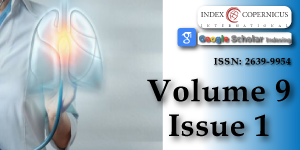Unveiling the Impostor: Pulmonary Embolism Presenting as Pneumonia: A Case Report and Literature Review
Main Article Content
Abstract
Pulmonary Embolism (PE) can present with symptoms resembling pneumonia, creating a diagnostic challenge, particularly in patients with comorbidities. We report the case of a 67-year-old male who presented with cough, hemoptysis, shortness of breath, fever, and pedal edema. Initially diagnosed with consolidation based on chest X-ray findings, he was treated with antibiotics. However, persistent symptoms prompted further evaluation, leading to the diagnosis of PE with pulmonary infarction and deep vein thrombosis on computed tomography pulmonary angiography and Doppler ultrasound. This case highlights the need to consider PE in the differential diagnosis of consolidation, particularly in high-risk individuals, to avoid delays in appropriate management.
Article Details
Copyright (c) 2025 Kumar S, et al.

This work is licensed under a Creative Commons Attribution 4.0 International License.
Sadeq AH, Farooqui MK, Sadiq Y. Pneumonia and concealed pulmonary embolism: A case report and literature review. J R Coll Physicians Edinb. 2022;52(2):142-146. Available from: https://doi.org/10.1177/14782715221103670
Stein PD, Beemath A, Matta F, Weg JG, Yusen RD, Hales CA, et al. Clinical characteristics of patients with acute pulmonary embolism: data from PIOPED II. Am J Med. 2007;120(10):871-9. Available from: https://doi.org/10.1016/j.amjmed.2007.03.024
Rahman KK, Durgeshwar G, Mohapatra PR, Panigrahi MK, Mahanty S. Pulmonary infarct masquerading as community-acquired pneumonia in the COVID-19 scenario: A case report. World J Respirol. 2024;13(1):1-6. Available from: http://dx.doi.org/10.5320/wjr.v13.i1.1
Goldhaber SZ, Hennekens CH, Evans DA, Newton EC, Godleski JJ. Factors associated with correct antemortem diagnosis of major pulmonary embolism. Am J Med. 1982;73:822-826. Available from: https://doi.org/10.1016/0002-9343(82)90764-1
Anderson DR, Kahn SR, Rodger MA, Kovacs MJ, Morris T, Hirsch A, et al. Computed tomographic pulmonary angiography vs ventilation-perfusion lung scanning in patients with suspected pulmonary embolism: a randomized controlled trial. JAMA. 2007;298:2743. Available from: https://doi.org/10.1001/jama.298.23.2743
Gibson NS, Sohne M, Gerdes VE, Nijkeuter M, Buller HR. The importance of clinical probability assessment in interpreting a normal d-dimer in patients with suspected pulmonary embolism. Chest. 2008;134(4):789–93. Available from: https://doi.org/10.1378/chest.08-0344
Payus AO, Rajah R, Febriany DC, Mustafa N. Pulmonary Embolism Masquerading as Severe Pneumonia: A Case Report. Open Access Maced J Med Sci. 2019;7(3):396-399. Available from: https://doi.org/10.3889/oamjms.2019.114
Evren H, Evren EÜ, Coşkun U. Pulmonary Embolism Mimicking Community-Acquired Pneumonia: A Case Series. Cyprus J Med Sci. 2019;4(1):60-62. Available from: https://cyprusjmedsci.com/articles/pulmonary-embolism-mimicking-community-acquired-pneumonia-a-case-series/doi/cjms.2019.752





